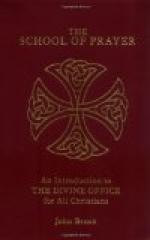Fourth Proposition:—The characteristic of the Roman Breviary hymns is to express with lively sentiments and with unction the noble ideas and beautiful sentiments of the supernatural order, in a simple manner, without prosodical pretension, yet having ever a true rhythm which sometimes vies with better compositions.
The characteristic mentioned in this proposition, which comes as a corollary from the three preceding propositions, is one which is clearly noted in our Breviary hymns. For by their very position in the Breviary, side by side with the Psalms, Scripture extracts and words of the Fathers, the Church shows her esteem and her use of these lyrics of prayer and praise. Again, the Church’s mind is shown by her retention of her hymns in her liturgy, notwithstanding the many efforts made to substitute a new hymnal. Up to the sixteenth century these Breviary hymns were universally esteemed. They were admired by St. Augustine. They are quoted and praised by St. Thomas in his Summa. Deays the Carthusian {1402-1471} wrote a beautiful commentary on them. Amongst all priests, secular and regular, the hymns were venerated and loved. Although there were many men of genius in every age and in every part of the Christian Church, the hymns escaped until the renaissance under Leo X. (1475-1521).
The lovers of everything classic and pagan were pained and exasperated at the venerable simplicity, the lack of prosody, the vagueness and crudity of the wording of the liturgical hymns. In 1531, Wimpheling, a priest of the diocese of Spire, produced a work, Himni de tempore et de sanctis ... secundum legem carminis diligenter emendati. Leo X., yielding to his own taste and the wishes of the learned innovators who were ardent students of pagan antiquity, commissioned Ferreri to compose a new hymnal for liturgical use. His book was allowed for liturgical use, but was not prescribed. It omitted all the old hymns sanctioned by the Church for centuries, and sung with fervour by thousands down the ages. “There are found in the work of Ferreri,” wrote Dom Gueranger, “all the images and all the allusions to pagan beliefs and usages which we find in Horace. Sometimes, it is only fair to say, his hymns are beautiful and simple ... but they follow generally and too servilely the pagan models ... but they are the work of strong and clear inspiration, which under the mask of classic diction shows itself in every part.” (Inst. Liturg. t. I., p. 370.) During the reign of Pope Paul III. new hymnals were issued, but the Breviary hymns were not removed. St. Pius V. in his reform of the Breviary did not touch the Breviary hymns. Clement VIII. in his reform added new hymns but did not remove nor retouch the old ones. This work remained for Pope Urban VIII. (1623-1644).




